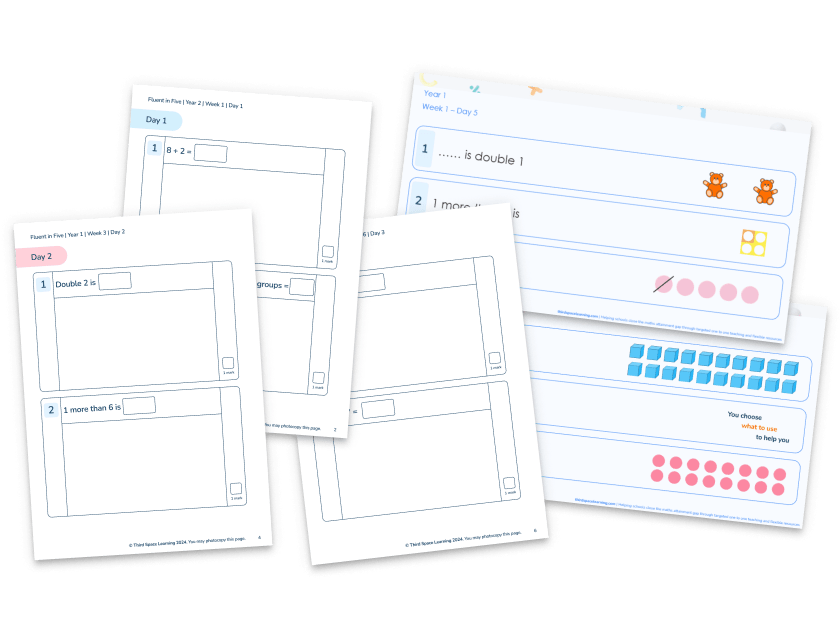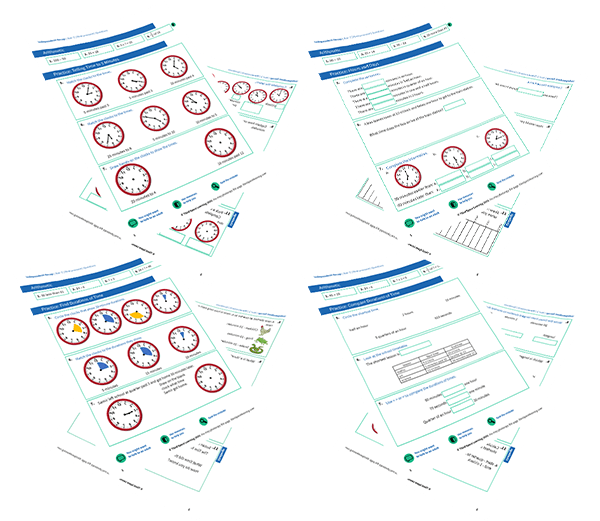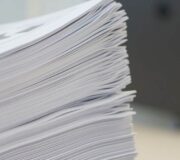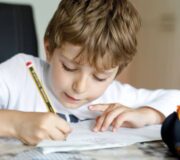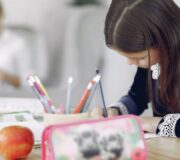Year 2 Maths Curriculum: Home Learning Toolkit For 6 Year Olds And 7 Year Olds
Year 2 maths often represents a huge change for children. With Key Stage 1 SATs at the end of the year, maths teaching often becomes more structured and the pace can be difficult for children to keep up with.
Fortunately, there are ways that you can support your child to thrive and to help them to continue their mathematical journey with confidence.
We’ve been working with primary school teachers to support 6 and 7 year old children with Year 2 maths tuition and Year 2 maths resources for many years. Although there is a lot covered during this year, here is the essence of what you need to know about how children are taught and learn maths in Year 2. Look out also for the year 2 maths worksheets we’ve provided – most of them free.
Step 1: Understand where your child’s needs are
No two children have an identical understanding of maths. While the National Curriculum spells out all the aspects of maths that a child will encounter in a given year, it might be the case that your child’s understanding in a particular aspect is significantly above or below the level that is expected of them at this stage.
So you must be prepared to react to your child’s current abilities and adapt the advice given here to suit the needs of your child. To start with however, the most important thing to do is to ensure that their learning from previous school years is secure…

Unlimited primary maths tutoring with Skye, the voice-based AI maths tutor.
Built on the same principles, pedagogy and curriculum as our traditional tutoring, but with more flexibility, reach and lower cost.
Join the schools already helping hundreds of primary pupils nationwide with Skye’s one to one maths tutoring.
Watch Skye in actionStep 2: Check the foundations
Your child’s maths learning in Year 2 and beyond will depend entirely on their understanding of number and counting from the Early Years Foundation Stage and Year 1. While it’s impossible to cover the entire list of concepts that your child needs to be fluent with, here are some key signposts to check:
1. Does your child know the counting sequence up to 20?
If not, practice counting from 1 to 20, checking that your child is correctly articulating the words, especially the endings of thirteen, fourteen, fifteen, etc.
2. Can your child count a number of objects up to 20 accurately, touching or moving one object at a time?
If not, practice this skill, slowing down the process to ensure that they recognise that each number they say corresponds to one object and that the number they finish with is the number of objects counted. (This is known as the cardinal principle.)
3. Can your child quickly recognise a number of objects between 1 and 10 in a ten-frame or on fingers without counting?
Children need to be able to quickly recognise numbers of objects fewer than 6 without counting them. This quick recognition is called perceptual subitising. They also need to be able to recognise numbers of objects greater than 6 by recognising smaller groups, combining them and by recognising familiar patterns (e.g. quickly recognising seven fingers by seeing five on one hand and two on the other). This is called conceptual subitising.
Developing a strong visual awareness of number will help develop your child’s number sense. Practice this by placing objects in a ten-frame (see below) and by repeated counting of fingers until children can subitise these numbers fluently. (In both cases, note how important it is for children to begin using 5 as an anchor for recognising larger numbers.)

Download free maths hub resources from our maths hub
Find what you need in our collection of free and premium maths resources for teachers and parents. Register to join for free (works best with Google Chrome).
Download Free Now!4. Can your child count up, starting on any number between 1 and 20?
If not, practise this, ensuring that your child begins and ends on different numbers (e.g. count up from 9 to 15).
5. Can your child count down, starting on any number between 1 and 20?
If not practise this, ensuring that your child begins and ends on different numbers (e.g. count down from 18 to 11).
6. Can your child recognise that numbers can be partitioned?
A great way to check this is to show children a small number of objects, get them to close their eyes, cover some of the objects and then ask how many are covered. This can be further practised by exploring part-whole models with objects and then with numbers (see below).
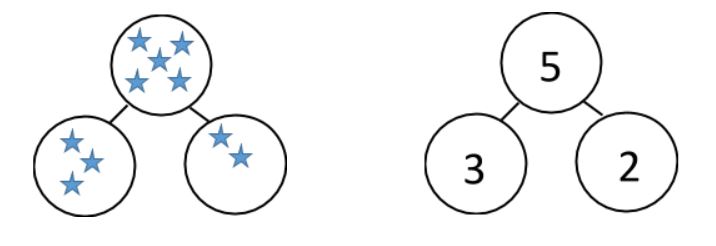
7. Has your child begun to understand place value?
Specifically, does your child understand the significance of two digit numbers and that each digit in a two-digit number represents something different due to its position (i.e. in 16, the 1 represents 1 ten and the 6 represents 6 ones.) Practising part-whole models for two-digit numbers that partition numbers into tens and ones can be useful way to develop understanding of this concept and place value more widely:
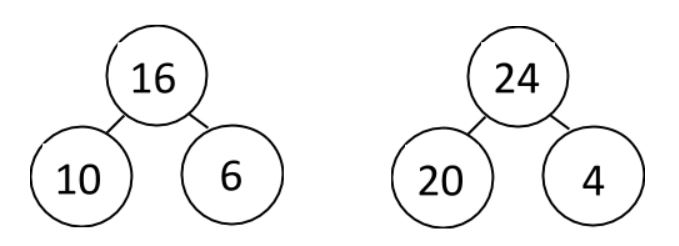
Step 3: Focus on PARTS of the Year 2 maths curriculum
Coming from an experienced class teacher, this might sound a little strange, but my advice would be to not overly concern yourself with every element of the KS1 maths curriculum.
While it can be useful and reassuring to familiarise yourself with the content that your children will be learning in school, attempting to teach or reteach all of the curriculum isn’t in your child’s best interests. Why? Because there are far more beneficial ways to support your child in their learning of mathematics.
It might seem like a good idea to break out the maths worksheets and help your child with problem solving questions, or try and work on more complex maths concepts like right angles, but it’s better to start out with the basics:
Number bonds inside 10
Children’s ability to fluently recall number bonds will be an essential component of their number sense as they progress. To help them develop this, practise lots of addition and subtraction of one digit numbers using a ten-frame. (This is one of many areas where children’s grasp of subitising pays off.)
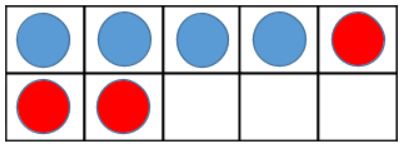
Over time this practice can be developed into quick recall of number facts based on the reasoning developed using ten-frames. Number bonds that together make ten are particularly important:
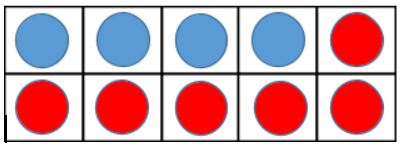
In every case, it is important that children recognise that each number fact isn’t isolated and that there are relationships between numbers (e.g. 4 + 6 = 10; 6 + 4 = 10; 10 – 6 = 4; 10 – 4 = 6).
If you’re unfamiliar with them, number facts are basic maths calculations that children should memorise and be able to recall straight away. By the end of Year 2, children are expected to know addition and subtraction facts to 20 (also known as number bonds) and multiplication and division facts for the 2, 5 and 10 times tables.
Number bonds inside 20
With number bonds inside 10 secured, this knowledge can be used to understand number bonds inside 20. While the end goal is fluent recall of these number bonds for use in mental and written addition, there are strategies that children can use at first to them learn these number bonds while developing their number sense:
Partitioning to make 10
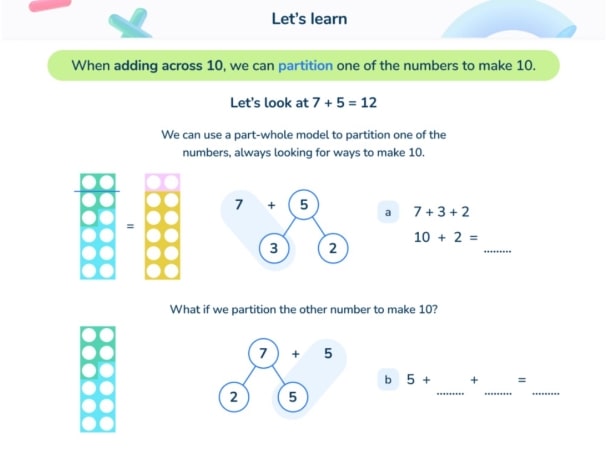
Counting on
One of the simplest strategies that children use for addition, counting on takes time and practice to develop. For example, children may initially instead use a count all strategy: when calculating 2 + 5, your child may show two fingers and five fingers and then proceed to count them all.
It’s important to note that this isn’t a ‘wrong’ strategy. As with all the strategies discussed here, it is important to recognise with children that they are developing a bank of strategies from which they can learn to choose the most efficient as their sense of number evolves.
To develop your child’s use of a ‘count on’ strategy, encourage them to recognise that addition can take place in any order (this is known as commutativity). Commutativity means it is more efficient to begin counting from the larger number.
Find out more about commutativity and other unfamiliar maths terms in this free primary maths dictionary.
You may find that your child struggles to count on to add. A common error is to include the start number. For example, in calculating 8 + 2, your child may say, “eight, nine,” and stop there as two numbers have been counted. To support an understanding of this strategy – and children’s understanding of the ordinal aspect of number (the idea that numbers have a position) – use a number-line:

Compensation
Compensation involves changing a calculation into one that is easier to calculate mentally. For example, 9 + 5 can be reformulated as 10 + 4, something that is easier to calculate if children’s understanding of place value has developed to an appropriate stage. This can be shown using pairs of ten-frames:

Near doubles
Once children have developed an understanding of doubles – another key concept to work on using objects and pictures – these can be used to support calculation of number bonds inside 20. For example, the number bond 6 + 5 can be thought of as double 5 then add 1. (You can also reformulate 6 + 5 as double 6 then subtract 1.)
While developing these strategies using objects and drawings e.g. tally charts, don’t be afraid to try such calculations using purely mental methods, asking your child to then explain their chosen strategy using words, pictures or objects.
If they reach a point where they state that they answer questions and “just knew” the answer, don’t discourage this. Equally, don’t rush them through to this end state of rapid recall. Some research suggests that building these number relationships on strategies such as compensation and near doubles helps children to use their number bonds more flexibly in future.
Multiplication in Year 2
While multiplication is very likely to have been introduced in Year 1, during Year 2 this will be learned in much greater depth. To support this, begin by helping your child to understand a basic interpretation of multiplication, repeated addition. 5 x 2 can be considered as 2 lots of 5 (or 5 + 5). Equally, 2 x 5 can be considered as 5 lots of 2 (or 2 + 2 + 2 + 2 + 2.) Develop this understanding by showing this using objects:

This representation of multiplication is known as an array. Arrays also serve to demonstrate that the multiplication calculations give the same answer regardless of the order of the numbers being multiplied (known as commutativity, as we saw with addition.) The array can just as easily be seen as 2 lots of 5 as 5 lots of 2.
To further support your child’s multiplication, it can be useful for them to learn to count in 2s, 5s and 10s, keeping track of how many have been counted using fingers or objects. This may lead to children solving calculations such as 6 x 5 without relying on objects or drawings, but do not rush this process. Allow them the time and space to develop the visual understanding of multiplication that will support later fluency.
In Year 2 there is some focus on multiplication tables, but only the basics – the 2, 5 and 10 times tables are covered.
Division in Year 2
Alongside multiplication, children will also learn about division in Year 2. To support this, ensure that they become familiar with two interpretations of division: grouping and sharing. Grouping involves seeing a calculation such as 10 ÷ 2 as, “How many groups of 2 can be made from 10?”

Sharing involves seeing 10 ÷ 2 as, “If I share 10 into 2 equal groups, how many are in each group?”

Again, your child’s counting in 2s, 5s and 10s can support their division using these numbers (e.g. 35 ÷ 5 = 7), but do not rush them towards this. Allow them to explore division using objects and pictures (including simple pictograms), understanding both of the interpretations described above.
Numbers up to 100
In Year 2, your child will be expected to be able to calculate using numbers up to – and a little beyond – 100. While you might want to get them to begin using formal written methods, resist this temptation in favour of developing their ability to work with numbers mentally.
Creating or printing a 1-100 number square for children to use at home (see below) is an excellent way to support your child’s understanding of a range of mental calculations and the patterns of our number system. Using a number square to answer addition and subtraction calculations – and noting patterns, such as adding or subtracting 10 – will further develop your child’s number sense.
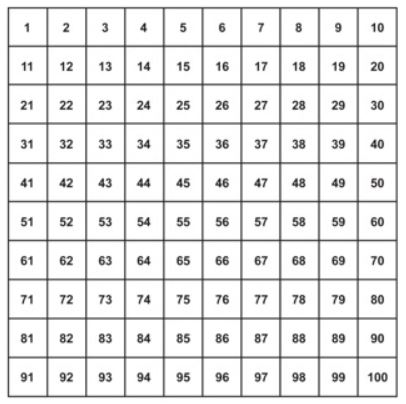
A 1-100 number-line is another valuable learning tool. Use it with your child to quickly find a number on the line, to compare numbers, using the mathematical language of greater than and less than, and the accompanying symbols, > and <, and practice ordering numbers.

Year 2 Maths – The rest of the Curriculum
The full list of things your child will learn at Year 2 includes:
- Place Value (up to 100)
- Addition and subtraction facts (up to 20)
- Multiplication and Division (including the 2, 3 and 5 times tables)
- Properties of shape – common 2D and 3D shapes
- Simple Fractions
- Measurement – Length and Height
- Position and Direction
- Time
- Money
- Problem Solving basics (both number problems and word problems)
How to help with other Year 2 Maths topics
As well as the detailed advice given in the earlier sections, there are ways that you can support your child across the mathematics curriculum. Engaging your child in lots of maths talk and everyday maths activities will go a long way. Examples of this include…
- Counting different amounts of money
- Practising how to measure length and height
- Using measurement scales
- Ordering a set of objects by size
- Comparing the size of objects using the mathematical language of greater than, smaller than, longer than, shorter than, etc
- Discussing and estimating the size and weight of objects using the mathematical language of heavier than, lighter than, etc
- Using watches and clocks and discussing time intervals
- Discussing temperature and using thermometers
- Discussing the shapes of everyday objects – both 2D shapes and 3D shapes
You should also take any opportunity to give your child’s learning of number bonds, multiplication, division and numbers up to 100 a real-world context.
The following articles contain useful ideas for practising these topics within a fun and engaging context for Year 2:
A final point
Your child is at the very beginning of their maths journey. While developing their understanding at this stage can be extremely valuable, try to make sure their learning does not become a chore, for you or for them.
It doesn’t take a great deal of imagination or enthusiasm to turn any part of this early learning into a brief, playful experience. You will also likely find that a ‘little-and-often’ approach will pay off, and as your child’s confidence as a mathematician grows, the more that they will want to engage with maths.
I hope that this advice proves helpful, and I wish you the best of luck in supporting your child.
DO YOU HAVE STUDENTS WHO NEED MORE SUPPORT IN MATHS?
Skye – our AI maths tutor built by teachers – gives students personalised one-to-one lessons that address learning gaps and build confidence.
Since 2013 we’ve taught over 2 million hours of maths lessons to more than 170,000 students to help them become fluent, able mathematicians.
Explore our AI maths tutoring or find out about primary school tuition for your school.
